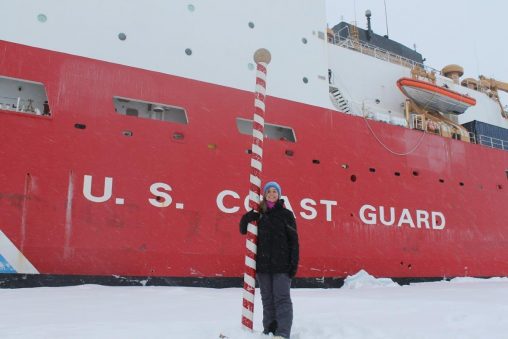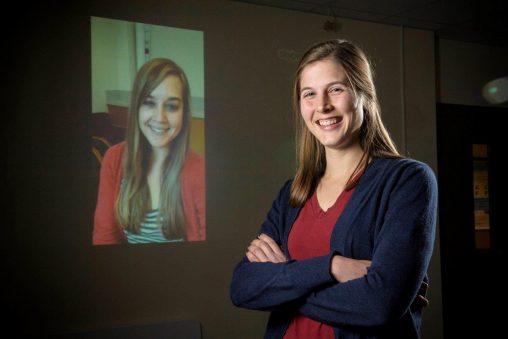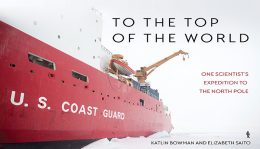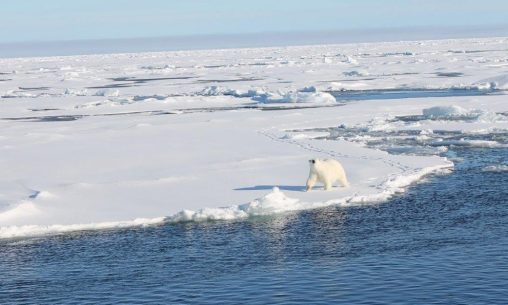Sleeping was a challenge. The sun never set for weeks at a time. And the crash of the ship’s metal hull into massive fields of ice coupled with the comings and goings of the research crew at all hours created a constant blare.
But then who needed to sleep anyway? The prospect of conducting pioneering research that could change the world’s understanding of the Arctic was a nerve-tingling stimulant for Wright State University graduate environmental sciences student Alison Agather and oceanographer Katlin Bowman, a Wright State alumna.
Both took part in a two-month expedition to the North Pole designed to take the pulse of the Arctic Ocean, measuring levels of toxic mercury in the water and ice.
And the experience gave Bowman the material to write “To the Top of the World,” a richly illustrated children’s book penned to inspire readers, especially young girls.

Katlin Bowman, who earned her bachelor’s degree and Ph.D. in environmental sciences from Wright State, at the North Pole during a research trip measuring levels of toxic mercury in the Arctic Ocean. (Contributed photo)
Agather and Bowman on Aug. 9, 2015, boarded the U.S. Coast Guard cutter Healy at Dutch Harbor, Alaska, perhaps best known as the home port for the crab fishermen of “The Deadliest Catch” television reality show. The Healy, which is longer than a football field, is the nation’s newest polar-capable icebreaker.
The 140-person crew included 50 scientists, half of whom were women, from Wright State, MIT, Florida State, Hawaii, Miami and other U.S. universities. Only Bowman and Agather measured mercury in the water. Other scientists on board were studying other elements, including arsenic, selenium and radioactive metals.
The research was supported by GEOTRACES, an international organization that observes and catalogues trace metals in the oceans. One goal of the expedition was to create maps of where and in what concentrations the elements exist in the Arctic Ocean.
Wright State’s role in the expedition was funded by an $180,000 grant from the National Science Foundation and directed by Chad Hammerschmidt, professor of earth and environmental sciences in the College of Science and Mathematics and an authority on mercury contamination.
Hammerschmidt says one of the big scientific questions to be answered is why mercury concentrations in Arctic wildlife have increased by a factor of six to 10 in the past 150 years compared to only a factor of three in the United States. The trip was part of Agather’s Ph.D. research on mercury levels in sediment and seawater in the Arctic. Little such research has been done.
“That is why this is such a novel thing,” she said. “The native populations up there depend on seafood as a major part of their diet. We’re concerned about levels in the water because that translates to how much is in the food.”
Most of the mercury in the environment is from human sources — half of it from the burning of coal. Once mercury falls into the ocean with rain, bacteria can transform it into methylmercury, the form that can accumulate in fish. Nearly all of mercury in humans comes from the consumption of marine fish.
The nervous system is very sensitive to all forms of mercury, especially methylmercury. Exposure to high levels can permanently damage the brain, kidneys and developing fetus. Effects on brain functioning may result in tremors, changes in vision or hearing and memory problems.
Some scientists theorize that the higher mercury levels in the Arctic stem from the multitude of rivers that empty into the Arctic Ocean. Another theory is that sea ice strips mercury out of the air.
“Temperatures in the Arctic are warming faster than anywhere else in the world,” said Bowman, who earned her bachelor’s degree and Ph.D. in environmental sciences from Wright State and is currently a postdoctoral research scholar at the University of California in Santa Cruz. “It was important for us to do this cruise now to understand why there is so much mercury in the Arctic and where it’s coming from, because the Arctic is changing really quickly and we want to understand whether that’s going to be good or bad in terms of mercury cycling.”

Katlin Bowman, left, and Alison Agather, graduate environmental sciences student. (Photo by Erin Pence)
After leaving Dutch Harbor, the Healy steamed through the Aleutian Islands and into the Bering Sea, threading the needle between the United States and Russia and taking water and sediment samples the whole way. After entering the Arctic Ocean, the ship angled toward the North Pole and began encountering seasonal sea ice and then permanent sea ice that had to be broken.
“On a huge icebreaker, it’s a jarring movement. You’re slamming into chunks of ice,” said Bowman. “You have to go pretty slow. Sometimes they fire up an extra engine.”
During the trip, Bowman and Agather took samples of snow, seawater and water just under the ice to try to understand what is happening at that transition point. They also walked out on the ice, took ice core samples and brought them back to the ship. About 1,300 samples were measured onboard in a laboratory.
Agather also brought sediment and particles suspended in water back to Wright State for analysis. In addition, Bowman collected DNA samples from microorganisms in the seawater that may be producing methylmercury in the water.
“I’m extracting DNA from those cells and I’m looking for specific genes or markers that are important for mercury chemistry,” said Bowman. “We’re trying to understand the biology side of how methylmercury is made in the Arctic Ocean.”
Summer temperatures above the Arctic Circle can range from 14 to 50 degrees. But at one point, the temperature plummeted to wind-chill temperatures of minus 30.
The Coast Guard crew would get off the ship and test the thickness of the ice — flagging thin spots — before letting the researchers out.
The scientists were outfitted with bright orange Mustang survival immersion suits, which have emergency inflation capability to protect them from falls into icy water. They also wore “bunny boots,” a nickname for Extreme Cold Vapor Barrier Boots used by the armed forces. The bulbous footwear retains warmth by sandwiching wool and felt insulation between two layers of rubber and is typically worn with heavy wool socks.
During the trip, the scientists saw polar bears, walruses, seals and an arctic fox. The researchers were briefed on the dangers of polar bears, and armed members of the Coast Guard crew set up protective perimeters when the scientists were out on the ice. The researchers retreated to the ship if weather conditions reduced visibility.
Agather and Bowman saw several polar bears while they were on the ship.
“They’re very curious,” said Bowman. “You can just watch the bear jump slowly from ice floe to ice floe, swim in the water, get really close to the ship and take in all of our smells.”
When the ship broke the ice, large chunks studded with Arctic char, a coldwater fish, would attract walruses. The walruses, which like to be in crowds, would also congregate on top of an ice floe until their weight would sink it. Then the animals would just swim to another ice floe.
Agather and Bowman had to deal with tight, communal spaces while living and working on the Healy. The 50 researchers ate together and many even did laundry at the same time. Sleeping was a challenge.
“Ships are really loud, so sleeping is a lot different,” said Agather. “At sea, people are always up, people are always working. It’s not very restful.”
The crew was served four meals a day that included an 11 p.m. feeding dubbed “MidRats,” for midnight rations.
“I was hungry all the time from working all the time,” said Agather.
The researchers enjoyed fresh fruit and vegetables for the first month of the expedition, but then had to go to cans. They ate a lot of pasta and potatoes toward the end of the voyage and ran out of milk and butter altogether.
“I was really happy to have a salad when I got back,” Agather said.
The researchers were immersed in a military-like culture while aboard the Healy. Each scientist carried a pager and had to check in on the ship’s network at least twice a day to make sure no one had fallen overboard.
At times during the trip, the sun never set. It would just circle the horizon. Bowman would find herself working on deck at 3 a.m.
“I felt like I was on a different planet,” she said.
The Healy arrived at the North Pole on Sept. 5. It was the first time in history a U.S. surface vessel reached the pole without being accompanied by at least one other ship.
“It was exciting, but also a little bit scary,” said Bowman. “Part of the reason we were able to do that is that the ice cover is decreasing. There is not as much ice in the Arctic as there was 15 or 20 years ago.”
The scientists celebrated the arrival by erecting a “north pole,” organizing a football game and taking a bunch of pictures. They later rendezvoused with a ship of German scientists.
Once the Healy headed south, the researchers continued to take samples. The ship arrived back at Dutch Harbor on Oct. 11, 2015, completing a 64-day expedition.
 Bowman’s book, “To the Top of the World,” co-written by author Elizabeth Saito, is targeted at readers age 6 through 11. It is designed to tell children about the expedition and a little bit about mercury pollution.
Bowman’s book, “To the Top of the World,” co-written by author Elizabeth Saito, is targeted at readers age 6 through 11. It is designed to tell children about the expedition and a little bit about mercury pollution.
Bowman believes the research trip will ultimately reveal the origin of all of the toxic mercury in the Arctic.
“I also think we’re going to have a better idea of what’s going to happen to the mercury cycle in this coming century as ice cover decreases and temperatures in the Arctic continue to warm,” she said. “It will take a while for us to have answers, but I think there is really good potential.”
“I think it’s important that I was able to write this from my perspective,” said Bowman. “We want kids to see a young girl who is a scientist. A lot of people think scientists are just these nerdy guys in white lab coats, but the reality is that we get to do really extraordinary things, like going to the North Pole.”
Funding to publish the book came from the National Science Foundation. All proceeds will be donated to nonprofit organizations supporting STEM education and ocean conservation. Books can be purchased at http://www.bookshopsantacruz.com/top-world-one-scientists-expedition-north-pole


 Nearly 1,500 students graduate at Wright State’s spring commencement ceremonies
Nearly 1,500 students graduate at Wright State’s spring commencement ceremonies  Wright State University and Premier Health more closely align operations, creating a transformational partnership
Wright State University and Premier Health more closely align operations, creating a transformational partnership  Bottom Line, Wright State partnership aims to increase access to college
Bottom Line, Wright State partnership aims to increase access to college  Wright State’s nursing program celebrates 50th anniversary
Wright State’s nursing program celebrates 50th anniversary  Wright State celebrates Student Success Champions
Wright State celebrates Student Success Champions 